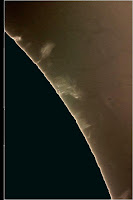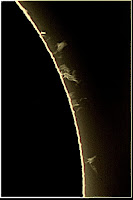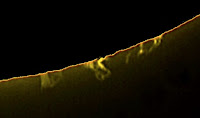*
There has been no point in attaching the camera so far. The cloud is coming from the SE and steadily thickening. I did a Home run. [Park] Then closed down AWR and the laptop and restarted both. All still seems well.
Friday: Overcast with early rain. I keep waiting for visible targets for Goto Slews. The Moon and Sun are approaching each other in the sky but the heavy cloud cover over the last few days isn't cooperating. I haven't even seen the Moon despite staring intently at passing holes in the clouds where the telescopes are pointing.
I can centre the sun in the 90mm with its Baader foil filter cap safely in place. Then slew to the moon and remove the filter temporarily to confirm the moon is centred. Gotos have never been remotely accurate enough, so far, to find daytime planets. Something I have always wanted to try. It was hard enough to find them in the dark with endless corrections required on the paddle after a Goto slew. Finding the moon with the drives was always complete pot luck too. Using guide stars for synchronisation and checking mounting alignment? No chance! Why have I put up with this crap for so long?
I wish I had the nerve to climb the huge plum trees behind the observatory. If I removed some branches I could see Polaris more often. The sheer height and risks of climbing such long branches puts me off. My longest double ladder reaches only 1/3 of the way. I have no idea if the branches would take my weight. Felling the huge tree would need a big tractor and chain out in the marshy field to avoid crushing my shed and observatory. Several huge branches curve right over the top of my buildings. Their spread must be 60' east to west.
The dome seams are leaking enough in places to warrant placing a few sandwich boxes on the base ring to keep the timber dry. If only I had known this when I dismissed the fibreglass calf rearing dome on the grounds of weight. The friction wheel drive would easily have coped with that problem. Though getting the dome segments up to the first floor would have required rather more ingenuity.
Bright sunshine after morning coffee found me in the observatory and set up for some H-alpha imaging. Whereupon it immediately clouded over. So I spent the waiting time emptying a full bucket worth of sandwich box rain collection. And still the sky darkens. Despite being promised sunny periods.
*

















